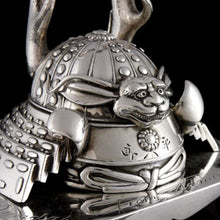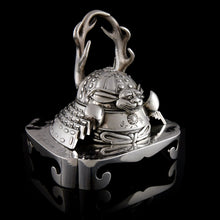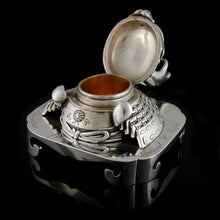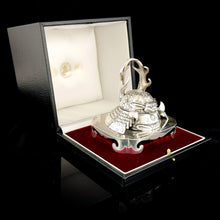Admiral Togo - Samurai Presentation Inkwell To a Highland Chieftan, 1910
Adding product to your cart
9cm (3.5in) x 9cm (3.5in) x 9cm (3.5in)
Silver. Presentation inkwell in the form of a Samurai helmet (kabuto), the hinged skull with crest (kawagata) formed as antlers for use as a pen rest, the canted rectangular base bearing presentation inscription ‘Captain Dundas from Admiral Count H. Togo, Tokyo 1910’. Raised on four integral inverted scroll bracket feet.
Read more
The present inkwell was a gift of gratitude from Imperial Japan’s ‘Nelson of the East’, Admiral Count Togo, to Captain Henry Dundas, RN, who was appointed by the Admiralty to accompany him during an official visit to Britain in 1908. Dundas first met Admiral Togo hitherto while holding senior appointments in the Far East. Accordingly Dundas made arrangements for Admiral Togo to visit places familiar to him from his time studying in Britain as a naval cadet between 1871 to 1878.
Marshal-Admiral Marquis Tōgō Heihachirō (1848-1934) was descended from the Samurai Shijo Kingo. As Commander-in-Chief of the Combined Fleet during the Russo-Japanese War of 1904–1905, he successfully confined the Russian Pacific fleet to Port Arthur, denying the Russia the opportunity of pouring large armies into Korea and thus threaten the Japanese homeland. The threat was so serious that the last army reserves were called up after the Japanese fleet suffered several severe losses to Russian mines in early 1904. Only Togo's cool judgement saved the day. His continued careful handling of the Japanese Navy in the eighteen month long war eventually ensured Japan’s victory, when he destroyed or captured much of the Russian relieving fleet that had steamed 18,000 nautical miles from the Baltic at the Battle of Tsushima in May 1905. The day before his death he was raised from Count to Marquis (kōshaku) in Japanese peerage. He remains deeply revered as a national hero in Japan, with shrines and streets named in his honour.

In February 1871, the young Tōgō and eleven other Japanese officer cadets were selected to travel to Britain to further their naval studies. Accordingly, Tōgō lived and studied in Britain for a period of seven years. The Japanese group was separated and Tōgō was initially sent to Plymouth. He studied history, mathematics and engineering at Portsmouth in order to prepare for admission to Royal Naval College at Dartmouth. When the Admiralty decided no places were to be made available at Dartmouth for the Japanese cadets, Tōgō was sent to HMS Worcester, the Thames Nautical Training College, moored at Greenhithe. Tōgō found the rations meagre and rebuffed the casual racism of the day with his fists when dimwitted British shipmates called him Johnny Chinaman. Gunnery training for the college was held aboard HMS Victory, at the time moored in Portsmouth harbour. Tōgō is recorded to have attended Trafalgar Day observances on the deck of Nelson’s flagship in 1873. He also attended Greenwich Royal Naval College.
Admiral Sir Charles Dundas was the 28th Chief of Dundas and was descended from Helias, son of Utred, son of Gospatrick, Prince of Northumberland. He entered the Royal Navy training ship Britannia in July 1872, the same term as John Rushworth Jellicoe. He became Captain in 1901 and served as captain of HMS Ocean from September 1905 until the beginning of 1908, at which time he joined the Naval Intelligence department. In March 1908, he was appointed Naval Attaché to Japan and China – a post he held until September 1910. He entertained Admiral Togo at his Scottish home during Togo’s 1908 visit to Britain and received in return a finely bound history of the Russo-Japanese War. Dundas was appointed a Naval Aide-de-Camp to King Edward VII in January 1909. He was promoted Rear-Admiral in 1910 on Special Service with Prince Louis of Battenberg, Vice-Admiral Commanding the Third and Fourth Divisions of the Home Fleet.













